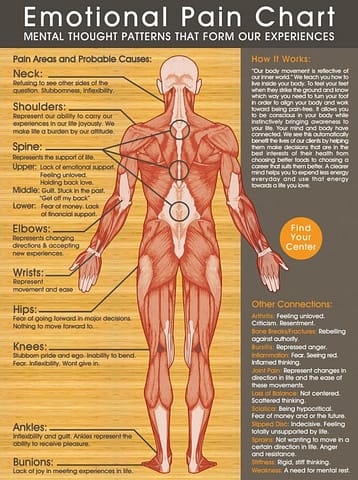The causes of chronic pain can be deep-seated, emotional, and even as basic as a really bad diet.
Treating these mysterious aches has become the mission of Gary Kaplan, DO, a pioneer of integrative medicine and director of the Kaplan Clinic for Integrative Medicine in McLean, Virginia. He treats people with chronic pain every day. In Kaplan’s new book, Total Recovery: Breaking the Cycle of Chronic Pain and Depression, he addresses the root causes of chronic pain, and how most doctors are going about treating it in all the wrong ways.
“Treating chronic pain is never as straightforward as treating a bacterial infection,” he writes. “As a medical scientist, I was convinced that when patients in chronic pain had a history of emotional, physical, and infectious assaults, all of those assaults must somehow be working together.”
In his decades of treating chronic pain, he’s found some surprising causes of people’s misery, such as these six:
 #1: Emotional trauma. Doctors are increasingly realizing that deep-seated emotional pain from a past trauma, be it abuse or post-traumatic stress, can manifest itself as chronic physical pain. Dr. Kaplan notes that research hasn’t yet uncovered what links the two, but in his practice, he writes, he’s found that patients who have chronic pain that doesn’t respond to traditional treatments have, upon further evaluation, often had some traumatic experience in their lives.
#1: Emotional trauma. Doctors are increasingly realizing that deep-seated emotional pain from a past trauma, be it abuse or post-traumatic stress, can manifest itself as chronic physical pain. Dr. Kaplan notes that research hasn’t yet uncovered what links the two, but in his practice, he writes, he’s found that patients who have chronic pain that doesn’t respond to traditional treatments have, upon further evaluation, often had some traumatic experience in their lives.
One prevailing theory, he says, is that emotional trauma, physical injury, or environmental toxins appear to stimulate microglia, molecules that live in the central nervous system that spew out a continuous supply of inflammatory chemicals whenever they’re stressed. Your body’s response to this constant inflammation manifests itself in two significant ways: chronic pain and psychological disorders like depression and anxiety.
Read More: 10 Questions Neuropathy Patients Should Ask Their Doctor
#2: Painkillers. Surprising, but true: Overusing pain killers dulls your body’s response to pain, so you need more, and more potent, painkillers to alleviate chronic pain. But that just leads to increased sensitivity to pain in the long run. Dr. Kaplan says this problem is particularly bad with prescription opiod painkillers, such as Vicodin or Oxycontin. Using painkillers to deal with chronic pain is “shortsighted,” Dr. Kaplan writes.

#3: Poor-quality sleep. Our perception of pain increases when the quality of our sleep is poor, Dr. Kaplan writes. Deep sleep is a time when
your muscles have an increased blood supply, which helps with tissue growth and repair. You can see an increase in generalized muscle pain, he adds, within just a week of not getting regular deep sleep. And sleeping pills don’t help, since they just put you to sleep without improving the quality of sleep, which means you might not reach those deep, pain-relieving stages you need to feel better.
#4: Your leaky gut. Seventy percent of your immune system is located in your gut, which is filled with nerves as well as tiny hairs in the walls known as villi that prevent your body from absorbing too many toxins. Taking too many painkillers, or even having food sensitivities like gluten sensitivity, can damage both the nerve endings and those villi, leading to a condition known as “leaky gut.” When your gut “leaks,” undigested food (with sometimes problematic proteins like gluten), bacteria, and other environmental chemicals that can cause those microglia to get stimulated and lead to chronic pain.
Read More: 5 Natural Neuropathy Treatments
#5: Magnesium deficiency. Magnesium is the fourth most abundant mineral in the body, Dr. Kaplan notes, and good health is practically impossible if you don’t have enough. And most of us don’t. In fact, 57 percent of Americans don’t get enough. But this vital mineral blocks your brain’s receptors of glutamate, a neurotransmitter that can cause neurons to be hypersensitive to pain. Dr. Kaplan says he prescribes intravenous magnesium to many of his chronic pain patients, but you can get your daily recommended amount easily if you load up on leafy greens, dried apricots, avocados, brown rice, almonds, cashews, and bananas.
#6: Lyme disease. Lyme disease is the most common vector-borne disease in the United States, carried predominantly by the black-legged, or deer, tick. Roughly 32,000 cases are diagnosed every year, and that number will surely rise as climate change allows ticks to survive longer and travel into new regions.
Dr. Kaplan writes that the standard treatment for Lyme disease is a two- to four-week course of antibiotics—which can damage your gut—but as much as 20 percent of treated Lyme sufferers develop Post-Treatment Lyme Disease Syndrome, which is characterized by achy joints and can linger six months or longer after treatment. Research into this syndrome is ongoing, he adds, but many scientists theorize that Lyme can provoke an autoimmune response that continues long after the antibiotics have killed the bacteria, leaving people suffering from debilitating pain even as tests don’t detect any lingering signs of the disease.
 Skip to content
Skip to content
